/Vehicles/Axis/Germany/02-mPanzers/PzKpfw3/File/7-Conversions.htm | Last Up-date: 24-05-2022
Panzerkampfwagen III Medium Tank
Conversions:
Tauchpanzer III
Le char submersible Tauchpanzer III fut conçu tout spécialement pour l' opération Zeelöwe (Lion de mer), l' invasion de l' Angleterre. Au total, 168 Panzers III Ausf.F (37 mm et 50 mm KwK), Ausf.G et Ausf.H ainsi que quelques Pz.BfWg III furent convertis, les derniers le furent fin 1940. Les chars ainsi convertis furent versés dans le Panzerabteilung A, unité spéciale mise sur pieds à Putlos au nord de l' Allemagne. Le Tauchpanzer III fut conçu pour se mouvoir sous 15 m d' eau et ainsi pouvoir approcher sans être repérés les plages défendues par l' ennemi. Sur le Tauchpanzer III toutes les ouvertures furent rendues étanches ou scellées. Les échappements furent équipés d' un système permettant aux gaz de sortir mais empêchant tout autre élément d' y pénétrer. Un tube de caoutchouc fut installé entre la tourelle et la caisse. Les orifices des canons et mitrailleuses étaient obturés par des couvercles en caoutchouc (notons que ces couvercles pouvaient être enlevés de l' intérieur lorsque le char regagnait la terre, ce qui est bien utile).
The submersible tank Tauchpanzer III was designed in particular for the operation Zeelöwe (Sea lion), the invasion of England. On the whole, 168 Panzers III Ausf.F (37 mm and 50 mm KwK), Ausf.G and Ausf.H as some Pz.BfWg III were converted, the last were to it at the end of 1940. The tanks thus converted were versed in Panzerabteilung A, special unit created in Putlos in the north of Germany. Tauchpanzer III was conceived to be driven under 15 m of water and thus to be able to approach without to be located the beaches defended by the enemy. On Tauchpanzer III all the openings were made tight or sealed. The exhausts were equipped with a system making it possible gases to leave but preventing any other element to penetrate there. A rubber tube was installed between the turret and the hull. The openings of the guns and machine-guns were sealed by rubber covers (let us note that these covers could be removed from interior when the tank regained the ground, which is quite useful).
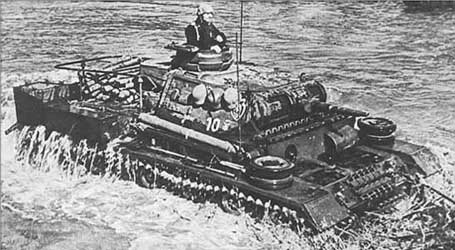 |
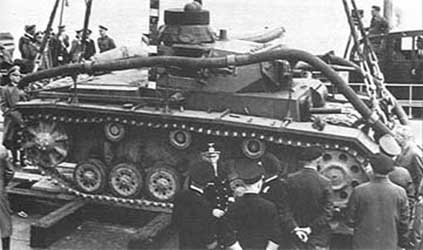 |
Tauchpanzer
III |
|
src: Site www.wwiivehicles.com |
src: Site Panzer
Page von Reitsch |
Pour pouvoir être utilisable, le Tauchpanzer III devait bien entendu être alimenté en air. Pour ce faire il fut équipé d' un snorkel flexible doté à l' autre extrémité d' un flotteur (équipé d' une antenne radio). Le Tauchpanzer III était également équipé d' une pompe pour évacuer l' eau qui aurait quand même réussi à pénétrer à l' intérieur du char. Pour pouvoir se diriger sous l' eau, car bien entendu le Tauchpanzer III était complètement aveugle comme n' importe-quel sous-marin, il fut équipé d' un gyrocompas. Le Tauchpanzer ne foula jamais le sol marin proche de l' Angleterre et encore moins ses plages car l' opération Zeelöwe fut finalement annulée après que la Lutwaffe ait perdu la bataille d' Angleterre. Le Tauchpanzer III furent donc modifiés pour le franchissement de rivières. Le snorkel flexible fut remplacé par un snorkel périscopique installé sur la coupole du commandant. Les Tauchpanzers III modifiés furent versés dans la 18e Panzerdivision et la 3e Panzerdivision et furent utilisés au combat pour la première fois lors de l' opération Barbarossa (invasion de la Russie) en 1941. Ils furent notamment utilisés pour le franchissement de la rivière Burg.
To be able to be usable, Tauchpanzer III was of course to be fed in air. With this intention it was equipped with a flexible snorkel equipped at the other end with a float (equipped with a radio antenna). Tauchpanzer III was also equipped with a pump to evacuate the water which would nevertheless have succeeded to penetrate inside the tank. To be able to move under water, because of course Tauchpanzer III was completely blind like a submarine, it was equipped with a gyrocompas. Tauchpanzer never moved on the marine ground near to England and even less its beaches because the Zeelöwe operation was finally cancelled after Lutwaffe lost the battle of England. Tauchpanzer III were thus modified for the crossing of rivers. The flexible snorkel was replaced by a periscopic snorkel installed on the cupola of the commander. Tauchpanzers III modified were versed in 18th Panzerdivision and the 3rd Panzerdivision and were used to the combat for the first time at the time of the operation Barbarossa (invasion of Russia) in 1941. They were in particular used for the crossing of the Burg river.
Drawings |
Befhelspanzer III
Afin de diriger les mouvements de larges formations blindées, les Allemands ressentirent le besoin de disposer de chars spéciaux de commandement. Le premier modèle construit fut le Kleiner Panzerbefehlswagen I Ausf.B (basé sur le Panzer I Ausf.B) qui fut cependant jugé trop petit et trop peu armé pour accompagner les autres chars au combat. Pour réaliser un char de capable d' accompagner les chars standards et d' accueillir le matériel radio nécessaire à un char de commandement, les Allemands convertirent le Panzer III en Grosser Panzerbefehlswagen III. La conversion ressemblait à un char standard si ce n' est que la tourelle était soudée ou boulonnée à la caisse, que le canon était factice et que des sabords de vision supplémentaires furent installées sur le pourtour de la superstructure et la mitrailleuse de caisse fut remplacée par un de ces sabords. La protection du char fut améliorée par des plaques additionnelles de 30 mm d' épaisseur. L' intérieur de la tourelle accueillait les différents postes radio et une tablette pour les cartes. Les postes radio étaient de type Fu 13, Fu 6 et Fu 7 à ondes ultracourtes ainsi que Fu 8 à ondes moyennes. Notons que certains exemplaires furent doté d' un poste de liaison air-terre pour la coordination avec la Lutwaffe. Le Pz-BfWg III était équipé de deux antenne-périscopiques et d' une large antenne-cadre sur le plateau arrière. L'équipage était composé d' un commandant, d' un officier d' état-major, de 2 opérateurs radio et du pilote. Le seul armement du char était constitué par la MG 34 flexible montée sur rotule au centre du faux masque de la tourelle.
Le premier modèle réalisé fut le Pz.BfWg III Ausf.D1 (Sd.Kfz.267(Fu 6 et Fu 8)/268 (Fu 6 et Fu 7)) comme on s' en doute était basé sur le Panzer III Ausf.D. Ce modèle produit à 30 exemplaires (entre juin 1938 et mars 1939), fut utilisé en Pologne et en France mais comme il souffrait d' une suspension plutôt faible il fut vite retiré du service.
In order to direct the movements of large armoured forces, the Germans felt the need to have special tanks of command. The first built model was Kleiner Panzerbefehlswagen I Ausf.B (based on Panzer I Ausf.B) which however was considered to be too small and too little armed to accompany the other tanks to the combat. To produce a tank of able to accompany the standard tanks and to accomodate the radio material necessary for a tank of command, the Germans converted Panzer III into Grosser Panzerbefehlswagen III. Conversion resembled a standard tank if it is not that the turret was welded or bolted with the hull, that the gun was factitious and that additional ports of vision were installed on the circumference of the superstructure and the machine-gun of hull was replaced by one of these ports. The protection of the tank was improved by 30 mm thickness additional plates. The interior of the turret accomodated the various radio stations and a table for the maps. The radio stations were of type Fu 13, Fu 6 and Fu 7 withultra-short waves and Fu 8 with medium waves. Let us note that certain specimens were equipped with an air-ground liaison station for coordination with Lutwaffe. Pz-BfWg III was equipped with two antenna-periscopic and broad antenna-frame on the rear deck. The crew was composed of a commander, a driver, 2 radio operators and a staff officer. The only armament of the tank was consisted the MG 34 flexible on ball mount in the center of the false mantlet of the turret.
The first model realized was Pz.BfWg III Ausf.D1 (Sd.Kfz.267(Fu 6 et Fu 8)/268 (Fu 6 et Fu 7)) as one of doubt had been based on Panzer III Ausf.D. Thismodel produced with 30 specimens (from June 1938 to March 1939), was used in Poland and France but as it suffered from a rather weak suspension it was quickly withdrawn from the service.
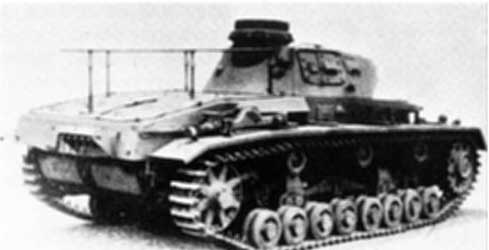 |
Pz-Befehlswagen
III Ausf.D1 |
src: Site Lexikon
der Wehrmacht |
Le second modèle fut basé sur la Panzer III Ausf.E et fut logiquement appelé Pz.BfWg III Ausf.E (Sd.Kfz.266/268). Plus efficace que le modèle précédent, il fut produit à 45 exemplaires et utilisé lors de l' invasion de l' Europe de l' ouest en 1940 puis jusqu' à la fin de la guerre.
The second model was based on Panzer III Ausf.E and was logically called Pz.BfWg III Ausf.E (Sd.Kfz.266/268). More effective than the preceding model, it was produced with 45 specimens and was used at the time of the invasion of Western Europe in 1940 then until the end of the war.
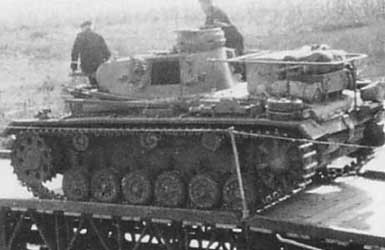 |
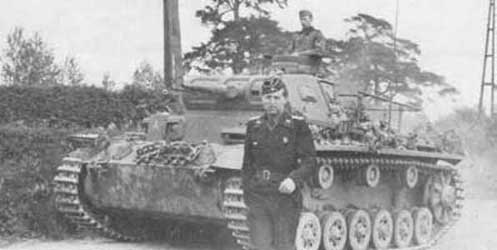 |
Pz-Befehlswagen
III Ausf.E |
|
src: Panzers Color 2 |
|
Le Pz-BfWg III Ausf.E fut suivit par le Pz-BfWg III Ausf.H basé sur la Panzer III Ausf.H. Ce modèle fut fabriqué à 145 exemplaires entre fin 1940 et fin 1941. Trente autres exemplaires furent construits durant l' hiver 1941-1942. Il était équipé de plaques supplémentaires de 30 mm boulonnées à l' avant et à l' arrière et des nouvelles chenilles de 400 mm. Les derniers exemplaires furent dotés d' un canon factice simulant le 50 mm KwK L/42 et non plus le 37 mm KwK L/46.5. Un périscope d' observation fut monté sur le toit de la tourelle. Ce modèle entra en service en 1941 pour l' opération Barbarossa.
Pz-BfWg III Ausf.E was followed by Pz-BfWg III Ausf.H based on Panzer III Ausf.H. This model was manufactured with 145 specimens between the end of 1940 and the end of 1941. Thirty other specimens were built during the winter 1941-1942. It was equipped with additional plates of 30 mm bolted in front and to the back and the new tracks of 400 mm. The last specimens were equipped with a factitious gun simulating the 50 mm KwK L/42 and either the 37 mm KwK L/46.5. A periscope of observation was assembled on the roof of the turret. This model entered in service in 1941 for the Barbarossa operation.
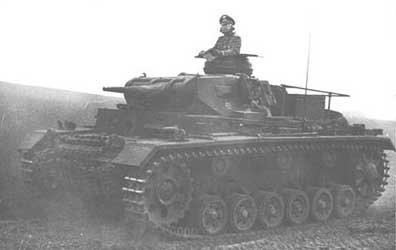 |
Pz-Befehlswagen
III Ausf.EH |
src: site Photos
Gallery of WW2
|
En 1942, 81 Panzers III Ausf.J furent reconvertis en chars de commandement ou Pz-BfWg III Ausf.K. Le total de projectiles embarqués fut réduits pour permettre l' installation des postes radio supplémentaires. Le char gardait son armement d' origine était donc toujours susceptibles d' être utilisé comme char de combat. A partir de 1943, tous les Pz-BfWg 3 seront convertis de cette manière. En 1943 104 chars de commandement équipés du canon de 50 mm KwK L/42 furent construits ainsi que quelques exemplaires dotés du 50 mm KwK L/60. Tous ces modèles perdirent l' imposante antenne-cadre montée à l' arrière qui fut remplacée par une antenne-étoile plus discrète car les chars de commandement étaient une cible prioritaire pour les artilleurs ennemis.
In 1942, 81 Panzers III Ausf.J was reconverted in the tanks of command or Pz-BfWg III Ausf.K. The total of embarked projectiles was reduced to allow the installation of the additional radio stations. The tank kept its armament of origin was thus always likely to be used like battle tank. From 1943, all Pz-BfWg 3 will be converted in this manner. In the 1943 104 tanks of command equipped with the gun of 50 mm KwK L/42 were built like some specimens equipped with the 50 mm KwK L/60. All these models lost the imposing one antenna-frame mounted on the rear deck which was replaced by a more discrete antenna-star because the tanks of command were a priority target for the enemy artillerists.
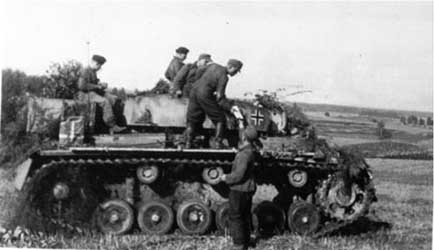 |
Pz-Befehlswagen III Ausf.K |
src: Site Lexikon
der Wehrmacht
|
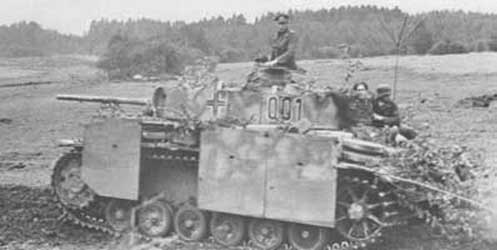 |
Pz-Befehlswagen III Ausf.M |
src: Panzerkampfwagen
III Medium Tank 1936-1944 (Osprey Military) New Vanguard N°27 |
Drawings |
En raison du développement de l' artillerie auto-motorisée, les Allemands ressentirent le besoin d' un véhicule blindé d' observation pour diriger les tirs. Pour réaliser ce véhicule, plusieurs Panzers III obsolètes furent convertis en Panzerbeobachtungswagen III (Véhicule blindé d' observation). Ces véhicules étaient dotés de plaques de blindage de 30 mm supplémentaires à l' avant et à l' arrière). Cependant la modification la plus remarquable fut la suppression du masque initiale et du canon. La mitrailleuse coaxiale fut replacée au centre à la place du canon et la position d' origine de celle-ci fut occupée par un canon factice, le tout sur un nouveau masque.
Because of the development of self-propelled artillery, the Germans felt the need for an armoured vehicle of observation to direct the shootings. To produce this vehicle, several Panzers III obsolete were converted into Panzerbeobachtungswagen III (armoured Vehicle of observation). These vehicles were equipped with additional armour-plates of 30 mm in front and to the back). However the most remarkable modification was the removal of the initial mantlet and the gun. The coaxial machine-gun was replaced in the center in the place of the gun and the position of origin of this one was occupied by a factitious gun, the whole on a new mask.
.ww2.jpg) |
.lex.jpg) |
Pz-Beobachtungswagen
III |
|
src: site Photos
Gallery of WW2 |
src: Site Lexikon
der Wehrmacht |
Au total, 262 PzBeobWg furent réalisés entre le début de 1943 et le printemps 1944. Ces véhicules furent assignés aux bataillons de Hummels et Wespes à partir de 1943 et furent utilisés jusqu' à la fin des hostilités.
On the whole, 262 PzBeobWg were realized between the beginning of 1943 and spring 1944. These vehicles were assigned with the battalions of Hummels and Wespes since 1943 and were used until the end of the hostilities.
Drawings |
Flammpanzer III
En 1943, environ 100 Panzers III Ausf.M (construits par MIAG) furent convertis par Wegmann en chars lance-flammes ou Panzer III Ausf.M (Fl) ou Flammpanzer III. La conversion était faite en remplaçant le canon et les munitions par une projecteur de flammes et des réservoirs de liquide inflammable. Le projecteur avait une portée de 55-60m selon les conditions météo. Les Flammpanzers III en majorité étaient équipés de plaques de blindage de 30 mm supplémentaires montées à l' avant de la caisse. Le matricule Sd.Kfz fut changé en Sd.Kfz.141/3 en raison du changement d' armement. Notons que le projecteur faisait feu à travers un canon factice destiné à tromper l' ennemi sur la vrai nature du char car les chars lance-flammes étaient des cibles prioritaires pour les artilleurs russes.
In 1943, approximately 100 Panzers III Ausf.M (built by MIAG) were converted by Wegmann into flame thrower tanks or Panzer III Ausf.M (Fl) or Flammpanzer III. Conversion was made by replacing the gun and the ammunition by a projector of flames and tanks of flammable liquid. The projector had a range of 55-60m according the weather. Flammpanzers III in majority were equipped with additional armour-plates of 30 mm mounted in front of the hull. The Sd.Kfz number was changed into Sd.Kfz.141/3 because of the change of armament. Let us note that the projector made fire through a factitious gun intended to mislead the enemy on true the nature of the tank because the flame thrower tanks were priority targets for the Russian artillerists.
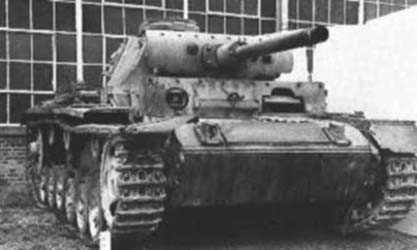 |
Flammpanzer
III |
src: Site Lexikon
der Wehrmacht
|
Les Flammpanzers III furent versés dans des bataillons spéciaux composés en principe chacun de 30 chars. La plupart furent utilisés sur le front russe contre les fortifications ennemies.
Flammpanzers III were versed in special battalions made up in theory each one of 30 tanks. The majority were used on the Russian front against the enemy fortifications.
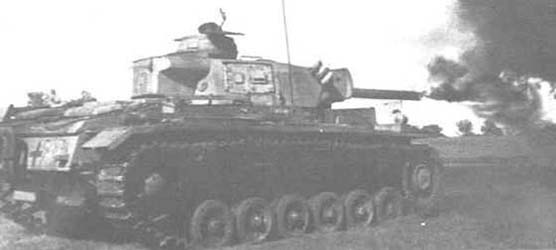 |
Flammpanzer
III |
src: site Photos
Gallery of WW2
|
Drawings |
Liste des conversions du Panzer III (le StuG III, le sIG 33B et le StuH42 sont décris dans un autre dossier):
Bergepanzer III: véhicule de récupération. Un total de 150 exemplaires furent convertis sur base de Panzers III retournés à l'usine pour réparation, entre mars et décembre 1944. Ces engins étaient équipés d'une superstructure en bois à la place de la tourelle et d'une grue capable de supporter une tonne de charge.
Munitionspanzer auf Fahrgestell Pz.Kpfw III: transport de munitions. En 1943, quelques Panzers III du type E, F et G furent convertis en transport de munitions sans tourelle. Ces engins étaient chargés d'approvisionner les chars Tigre.
Pionierpanzerwagen auf Fahrgestell Pz.Kpfw III: cette conversion fut réalisée à partir de Panzers III Ausf.L/M dont la tourelle avait été enlevée et remplacé par un espace cargo en bois. Ces véhicules transportaient de chaque côté des éléments d'un Pionierbruecken (pont).
Pz.Kpfw III Ausf.N als Schienen-Ketten Fahrzeug SK1 (75mm KwK L/24) : 2-3 prototype de cette conversion furent produits en 1942 et début 1943. Il s'agissait d'un char capable de se mouvoir sur rails de chemins de fer par l'adoption de galets de véhicule ferroviaire. Ces véhicules devaient en principe protéger les convois ferroviaires sur le front est.
Minenraumpanzer III: il s'agit d'un char anti-mines développés par Krupp. Il fut jugé inefficace et le projet ne fut pas développé.
Pz.Kpfw III Ausf.H mit 150mm sIG 33: canon d'assaut (Sturmpanzer) convertis sur le terrain en Afrique du Nord sur base de Panzers III Ausf.H endommagés. Ces chars utilisaient simplement le canon, le bouclier, les rangements d'outils et de munitions du Sturmpanzer II dans une superstructure ouverte.
Flakpanzer III: char de DCA. En 1945, on pensa utiliser les châssis des Panzers III devenus obsolètes pour fournir un char de DCA équipé des tourelles Wirbelwind (4x20mm Flak) ou Ostwind (1x37mm Flak). Une commande de 90 exemplaires sera bien effectuée mais la fin de la guerre y mis un terme.
Munitionsschlepper III: transport de munitions pour les unités de Ferdinand/Elefant
Artillerieschlepper auf Pz.Kpfw III: tracteur d'artillerie.
Pz.Kpfw III Ausf.G/H mit Schachtellaufwerk: prototype de char-bulldozer doté d'une nouvelle suspension à galets imbriqués (FAMO).
Notons encore que 110 tourelles de Panzers III seront utilisés sur les fortifications du "Mur de l'Atlantique" en France et de la "Ligne Hitler" en Italie.
Listing of Panzer III conversion (StuG III, sIG 33B, StuH42 are the object of another file):
Bergepanzer III: recovery vehicle. A total of 150 specimens were converted on the basis of Panzers III returned to the factory for repair, between March and December 1944. These machines were equipped with a wooden superstructure in the place of the turret and with a crane able to support a ton of load.
Munitionspanzer auf Fahrgestell Pz.Kpfw III: transport of ammunition. In 1943, some Panzers III of the type E, F and G were converted into transport of ammunition without turret. These machines were charged to supply the Tiger tanks.
Pionierpanzerwagen auf Fahrgestell Pz.Kpfw III: this conversion was carried out starting from Panzers III Ausf.L/M whose turret had been removed and replace by a wooden cargo space. These vehicles transported each side elements of Pionierbruecken (bridge).
Pz.Kpfw III Ausf.N als Schienen-Ketten Fahrzeug SK1 (75mm KwK L/24): 2-3 prototype of this conversion were produced in 1942 and at the beginning of 1943. It was about a tank able to move on railroads by the adoption of road wheels of railway vehicle. These vehicles were to in theory protect the railway convoys on the Eastern front.
Minenraumpanzer III: it is about a tank anti-mines developed by Krupp. It was considered to be ineffective and the project was not developed.
Pz.Kpfw III Ausf.H mit 150mm sIG 33: assault gun (Sturmpanzer) converted on the ground into North Africa on the basis of Panzers III Ausf.H damaged. These tanks used simply the gun, the shield, the arrangements of tools and ammunition of Sturmpanzer II in an open superstructure.
Flakpanzer III: tank of DCA. In 1945, one thought of using the chassis of Panzers III become obsolete to provide a tank of DCA equipped with the turrets Wirbelwind (4x20mm Flak) or Ostwind (1x37mm Flak). An order of 90 copies will be well carried out but the end of the war put an end to it.
Munitionsschlepper III: transport of ammunition for the units of Ferdinand/Elefant.
Artillerieschlepper auf Pz.Kpfw III: artillery tractor.
Pz.Kpfw III Ausf.G/H mit Schachtellaufwerk: prototype of tank-bulldozer equipped with a new suspension with overlapping road wheels (FAMO).
Still let us note that 110 turrets of Panzers III will be used on the fortifications of the "Atlantic Wall" in France and "Hitler Line" in Italy.
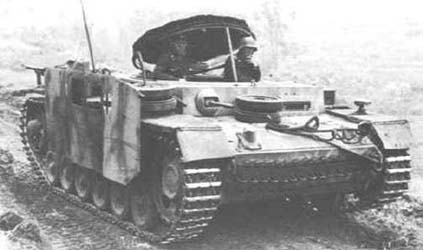 |
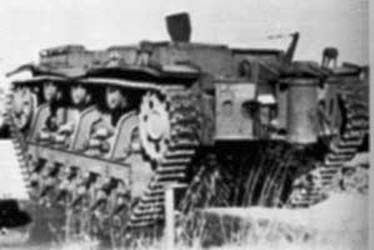 |
Bergepanzer III
|
Mineraumpanzer III |
src: site Photos
Gallery of WW2 |
src: Site Lexikon
der Wehrmacht |
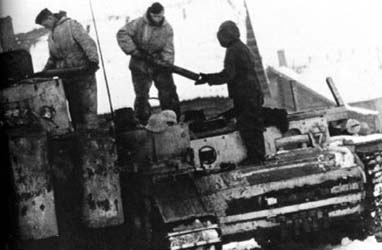 |
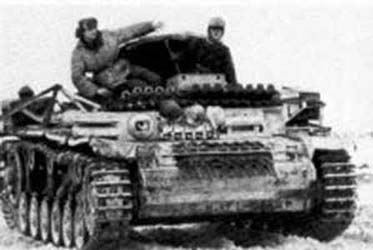 |
Munitionspanzer
III |
Instandsetzungspanzer-III |
src: Site Lexikon
der Wehrmacht |
src: Site Lexikon
der Wehrmacht |
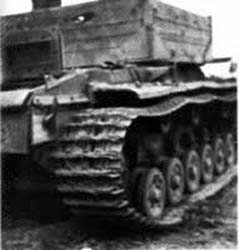 |
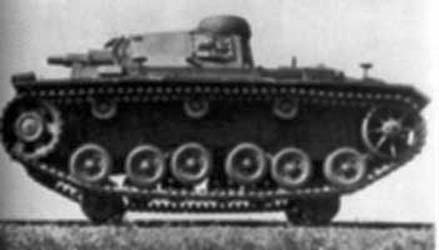 |
Panzerschlepper
III |
Panzer III Schienenfahrzeug |
src: Site Lexikon
der Wehrmacht |
src: Site www.wwiivehicles.com |
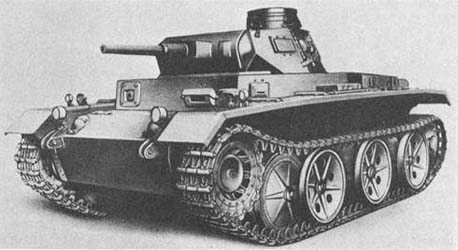 |
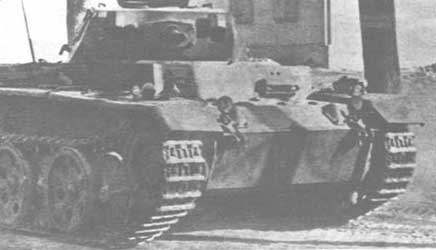 |
Panzers
III mit FAMO suspension
|
|
src: site Photos
Gallery of WW2 |
src: site Photos
Gallery of WW2 |
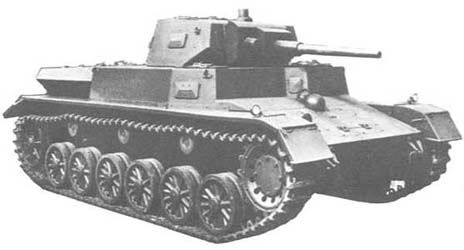 |
Krupp-Zügfuhrerwagen |
src: site Photos
Gallery of WW2
|
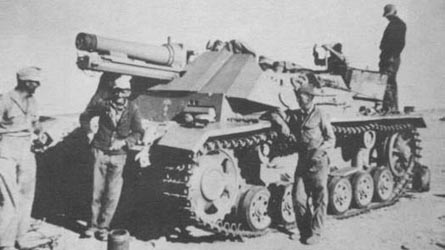 |
Sturmpanzer III du DAK en afrique du Nord. |
Sturmpanzer III Bison
of DAK in North Africa.
|
src: Site Lexikon
der Wehrmacht
|
Drawings |
Sources:
- Pz.Kpfw III in action, Armor Number 24 (squadron/signal publications, inc.)
- Connaissance de l'Histoire (Hachette) - N°17 - " Les chars de combat allemands 39-45"
- Connaissance de l'Histoire (Hachette) - N°5 - " Véhicules blindés allemands 39-45"
- Les Blindés de la Seconde Guerre Mondiale (Atlas)
- Panzerkampfwagen III Medium Tank 1936-1944 (Osprey Military) - New Vanguard N°27
- Site "Achtung Panzer" - http://www.achtungpanzer.com
- Site "Germany's vehicle history" - http://www.wwiivehicles.com
- Site "Second World War Armour" - http://www.onwar.com/tanks/index.htm